Text
Pixel and Flavor: Illustrating the Essence of Chinese Cuisine
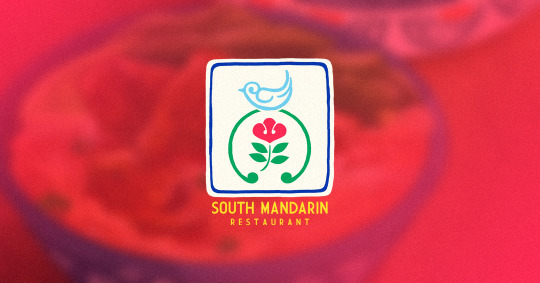

A few years ago, I designed a logo and a set of food illustrations to give a fresh look to a family restaurant that recently passed down to the younger generation.

Drawing Chinese cuisine is like crafting a complex dish—each layer matters. It's all about getting those layers right, just like the flavors in a good stir-fry. Took some time to get each dish just perfect, but it was worth it.
As the wise Cleaner from Toy Story 2 says: "You can't rush art!"

South Mandarin Restaurant is located at BF Homes, Parañaque City, Philippines.
© Kenny Tai. All Rights Reserved • R.A. 8293
#illustration#food art#food#kenny tai#design#art#philippines#manila#visual development#foodie#foodporn#Chinese food#chinese cuisine#food illustration
9 notes
·
View notes
Text

2🍑2 4
5 notes
·
View notes
Text

Just found out that August 10th is International Lazy Day.
#Lazy Day#illustration#kenny tai#art#philippines#character design#manila#visual development#visdev#sleepy girl#chilling#just chillin#good morning
6 notes
·
View notes
Text
Santa Cruz, Manila
Part 01 : The Cemeteries
Amidst the vibrant chaos of urban life in Manila, one can discover a solemn sanctuary that whispers tales of the past - the old cemeteries of Santa Cruz. As a district veiled in both melancholy and forgotten grace. Its old cemeteries, like missing chapters of a novel, exude a sense of neglect and abandonment.

In this corner of Santa Cruz, the once-pristine graves, now weathered and crumbling, bear witness to lives left untended and memories lost to time's relentless passage. Here, amidst the faded epitaphs and mossy stones, the echoes of forgotten souls whisper, the weight of unspoken stories hangs heavy in the air, yearning for the solace of remembrance.
Image above: Manila North Cemetery
Image below: Manila Chinese Cemetery

The old cemeteries of Santa Cruz are veritable archives of the human experience, where the past's timeless beauty reveals itself amidst gravestones and mausoleums. Here, Manila's history finds a poignant resting place, etched in the city's collective memory of life and death.
“For the forgotten dead, both heroes and nobles, Lacrimosa Santa Cruz, by their tombs she trembles.”
Part 02 : From “Congratulations” to “Condolence”
Santa Cruz, like a faithful companion throughout the journey from birth to death, whispers its sentiments through the language of flowers - a silent communication that speaks volumes.

In the northern expanse of this district, a somber path unfolds, lined with hospitals and medical establishments that gradually give way to the solemnity of cemeteries.
This slender district, resembling an aisle, gracefully escorts you along its hallow avenue, accompanying you until the very end, akin to a devoted guide on this transformative passage of life.
Part 03 : Fuente de Vida

At the southern part of Santa Cruz, where the bustling streets converge in a symphony of chaos and vitality, stands the Carriedo Fountain in Plaza Santa Cruz. Here, amidst the cacophony of hurried footsteps and blaring horns, a testament to vigor and life emerges, defying the somber ambiance that envelops the district's northern realms of cemeteries and hospitals.
The fountain becomes an audacious centerpiece, its cascading waters dance with fervor, a metaphorical rebellion against the relentless flow of time. Its grandeur is a stark contrast to the humble dwellings and makeshift stalls that populate the vibrant streets nearby, mirroring the chaotic rhythm of the surrounding urban theater.
Amidst the unapologetic raucous and vivacious surroundings, the Carriedo Fountain stands tall, a testament to the indomitable human spirit that thrives even in the most tumultuous of circumstances.
#Manila#Philippines#Santa Cruz#Manila North Cemetery#Manila Chinese Cemetery#Lacrimosa#Carriedo#Dangwa Flowers#flower market#visual development#character design#Manila Girls#Kenny Tai#life and death
18 notes
·
View notes
Photo

Carinderia
The term "carinderia" is believed to have originated from the Tagalog word "kari", borrowed from the Indian word "curry". The dish was adopted by Filipinos either from trades, regions or from Indian immigrants, and thus "karihan" or "kariyan" was used to describe a place where food, particularly the Filipino dish "kare-kare," was served. By observation, the hispanicization to some Tagalog words, where most store names in Spanish are formed from the name of the main product they sell and putting the ending '-ería' (e.g. panadería, frutería, perfumería). As a result, the word "carinderia / karinderya" was coined and used up to the present day.
The month of April has a lot to celebrate and raise awareness such as Earth Month, Filipino Literature Month, and Filipino Food Month, reminding us to savor our culture and be mindful of nature.
#Filipino Food Month#Filipino Food#Filipino Cuisine#South East Asian#Manila#philippines#carinderia#Earth Month#Illustration#art#Manila Girls#Philiipines#visdev#visual development#Filipino Literatiure Month
40 notes
·
View notes
Photo


Erik, or better known as, "The Phantom".
According to Gaston Leroux, the author of the 1910 novel "Le Fantôme de l'Opéra", Erik is described as corpse-like and is referred to as having a "death's-head" (human skull) throughout the story. He has no nose, and his eyes are sunken so deep in his skull that all that is seen are two eye sockets, except when his yellow eyes glow in the dark. His skin is yellowed and tightly stretched across his bones, and only a few wisps of dark brown hair are behind his ears and on his forehead. His mouth is never described in as much detail, but is referred to as a “dead mouth” by Christine, and Erik acknowledges that his mouth is abnormal when lifting up his mask to display ventriloquism. He is described as extremely thin, so much so that he resembles a skeleton.
#Phantom of the Opera#le fantome de l'opera#Phantom#Erik#Character Design#musical#art#broadway#gaston leroux#fanart#visual development#visdev#Illustration
528 notes
·
View notes
Text

Sketch 04 : Slow sales day in Manila Chinatown.
#illustration#kenny tai#art#philippines#character design#design#manila#color mood#manila girls#binondo#chinatown#people watching#ongpin#sketch#doodle#sketch dump#art dump#vendor#market#fruit vendor#noor et balnc#blakc and white
3 notes
·
View notes
Text
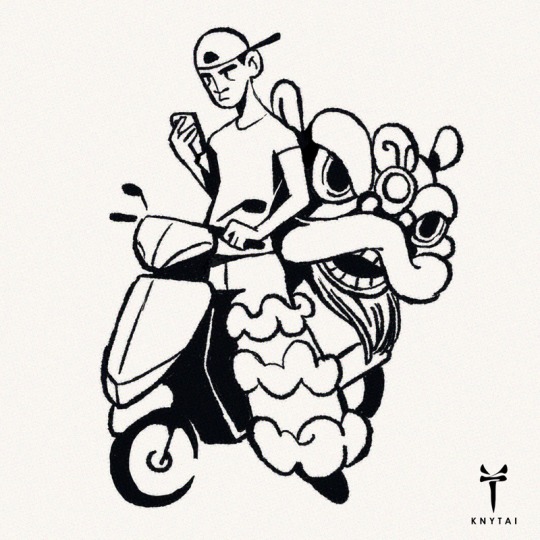
Sketch Break 03 : Dispatch for the Lion Dance
#illustration#kenny tai#art#philippines#character design#design#manila#binondo#lion dance#people watching#doodle#sketch#black and white#noir et blanc#les gens#sketch dump#art dump
32 notes
·
View notes
Photo
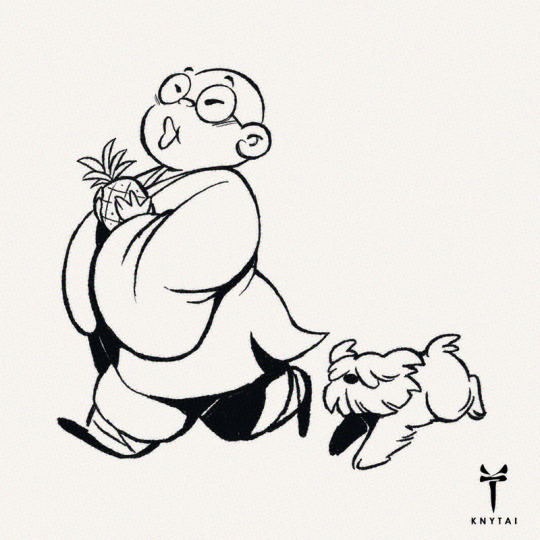
Sketch Break 02 : Post New Year Offerings
#buddhism#monk#monks#buddha#illustration#Character Design#people#sketch#doodle#Black and White#art#visual development#sketch dump#art dump#kenny tai
2 notes
·
View notes
Text

Sketch Break 01 : Scheduling for Prayers on the 49th Day
#illustration#kenny tai#art#character design#design#manila#black and white#doodle#sketch dump#sketch#monk#buddhist#buddhism#auspicious
1 note
·
View note
Note
Why is hermes mucurio mute
His tongue was cut by the Japanese and then sewn by the Dra. Jo.
0 notes
Text
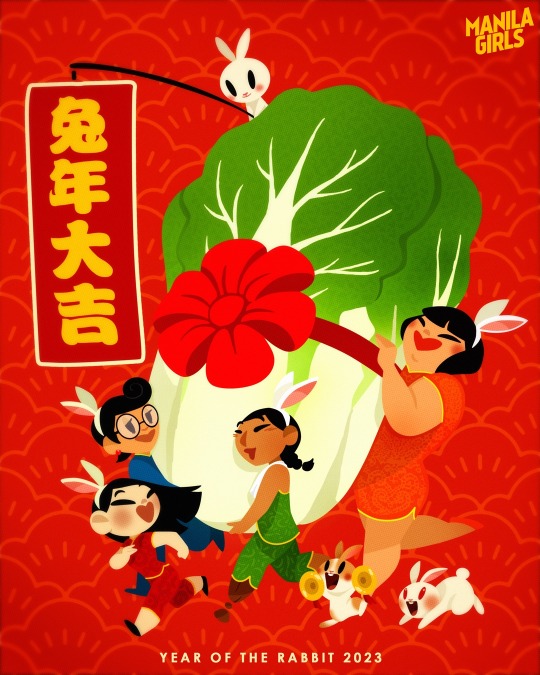
Happy Lunar Year of the Rabbit 🐰🧧
#art#new year#illustration#kenny tai#philippines#character design#design#rabbit#chinese new year#lunar new year#year of the rabbit#gong xi fa cai#kung hei fat choi#manila girls#manila#binondo
27 notes
·
View notes
Photo

Viva Magenta Bunny for 2023
#new year#viva magenta#rabbit#bunny#tea time#nap#afternoon#illustrtation#color mood#magenta#year of the rabbit#tea#art
2 notes
·
View notes
Photo
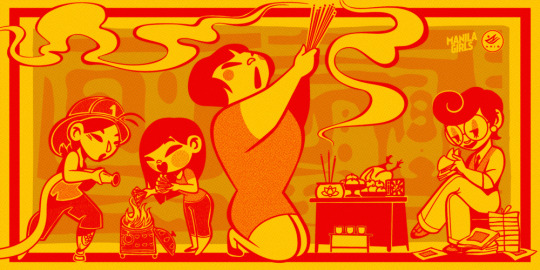
Ghost Month • 鬼月 (guǐ yuè) • 29 July - 26 August 2022
The seventh month of the Lunar Calendar in Taoism and Buddhist culture, which is considered to be a cautious month of the year. It is believed that the gates from the underworld are opened on the first day for the spirits to roam the earth where they seek food and entertainment. People pay respects for departed loved ones and acknowledge the presence of the wandering spirits with food offerings, prayers, and burning joss papers.For believers, major decisions from personal to business aspects are often delayed or avoided for this month and vigilance is maintained to prevent any unwanted encounters or circumstances. Or to simply put, staying clear from bad luck.
Ghost Festival • 中元節 (zhōng yuán jié) • 12 August 2022
The 15th day of Ghost Month, the festival, is the most important day. In the evening, people would feast and leave an empty chair around the table for the deceased in the family, treating them as if they are still living. Other South East Asian cultures even offer theater-style entertainment to the wandering ghosts as they believe that by pleasing spirits, they won’t be harassed. Here in the Philippines, visiting temples, praying, and food offerings is a simple gesture to acknowledge the dead and that they are not forgotten.
Read more about the Ghost Month with the following articles:
Learn 5 Chinese Words Related to Ghost Month & Taboos to Avoid
Hungry Ghost Festival
Ghost Festival
#Ghost Month#Ghost Festival#中元節#鬼月#Chinese culture#Manila#Philippines#Manila Girls#Taoism#Buddhism#ghost#spirit#dead#for the dead#盂蘭盆節#Ghost Day#Chinese Filipino#Chinoy#Tsinoy#South East Asia#Binondo#Escolta#San Nicolas#Divisoria#illustration#joss paper#character design#visual development#kenny tai
26 notes
·
View notes
Photo
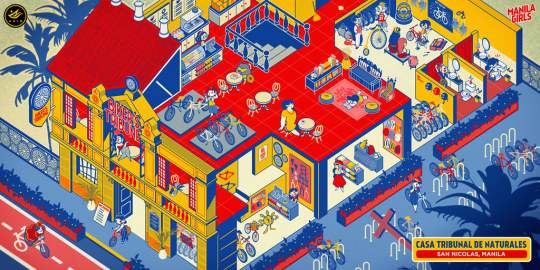
Casa Tribunal de Naturales
San Nicolas, Manila
Another wishful thinking of adaptive-reuse on heritage houses! This time, re-imagined as a bike shop-café.
About two centuries ago, before locals settle disputes via TV/online shows for instant justice, a lonely structure squeezed between two high-rise buildings along Asuncion Street was the Casa Tribunal de Naturales. This used to be the courthouse that caters to the natives (Chinese and Mestizos) to settle cases and to detain the accussed that was led by a local gobernadorcillo, equivalent of today’s town mayor.
The first two rooms are lowered detention cells, possibly for each gender. A hallway leading an open patio at the back with a stock room and two restrooms. Second floor was the courtroom, the gobernadorcillo’s office, archive room, and an arms depot at the back. Over the roof are the air vent stacks.
Like many of the heritage houses in Manila, it remains abandoned and rotting in decay, which is at high risk of demolition for another souless rectangular building that caters a car-centric city. This is a call for heritage preservation and bike justice on roads for a pedestrian-friendly future in the city.
Let’s hope! Otherwise, just dream.
References:
• Kaladkarin Diaries
• Center for Filipino Architecture
• Three Centuries of Binondo Architecture 1594–1898: A Socio-Historical Perspectiveby Lorelei D. C De Viana
Read more about the structure.
#Manila#Manila Girls#culture#heritage#art#illustration#houses#house#visual development#visual art#design#Philippines#Casa Tribunal de Naturales#tribune court#courthouse#Spanish-Filipino#Filipino#concept art#structure#architecture
9 notes
·
View notes
Photo
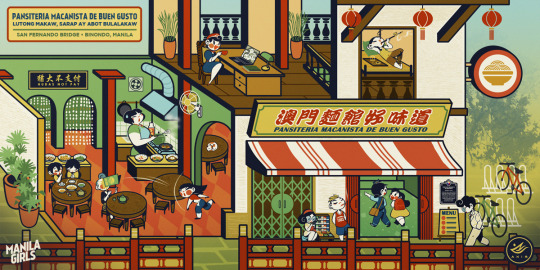
Been obsessing the 19th century noodle house, "Pansiteria de Macanista y Buen Gusto" since a personal encounter of the structure during the Binondo - San Nicolas tour back in summer of 2019.The establishment roughly translates as "Tasty Macanese Noodle House".
According to historical archives, the three-story commercial accessoria is owned by Don Serverino R. Alberto in 1880. The floor plan showcases the commercial divisions in its design by the Chinese-Filipino community. The former establishment was also mentioned in the 25th chapter of "El Filibusterismo", the second novel of Jose Rizal.
Re-imagined illustration above (for personal amusement) is a study of the first and second floor of what could have been a possible adaptive reuse of the building while retaining the panciteria brand and giving reverence of its past.
To know more about the pansiteria and the rest of the heritage sites, read more on this article.
Enjoy!
#jose rizal#binondo#manila#philippines#san nicolas#pancit#panciteria#macanese#cuisine#chinese filipino#chinoy#filipino#architecture#illustration#visual development#visdev#art#background design#restaurant
37 notes
·
View notes
Text

A city is better experienced when traveling by a pair of feet or by a pair of wheels, while intimately reconnecting our roots free from the walls of a four-wheeled vehicle.
Late post, an illustration for Manila Day at 451st.
#illustration#kenny tai#art#philippines#character design#design#manila#visual development#visual development art#filipino#manila girls#black and white#bike#bicycling#velo#cycling#filipina
67 notes
·
View notes